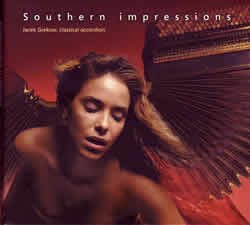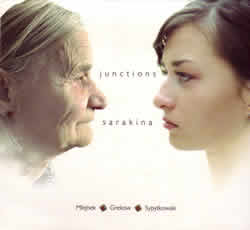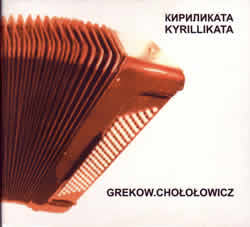The Free-Reed Review
Critiques of Compact Discs, Books and Music
Scores
CD Review: Grekow, Jacek: Southern impressions, Junctions, Kyrillakata

total time: 46:24
recorded: July 2006 & Jan 2007
review date: September 2007
|
Southern impressions
Selections
| 1 |
Isaac Albéniz (1860‑1909) |
Cantos de Escaca, Op.232 No, 4. Corcoba |
5:32 |
| 2 |
Enrique Granados (1867‑1916) |
Danzas espacolas, Op. 37 No. 5. Andaluza (Playera) |
4:54 |
| 3 |
Isaac Albéniz |
Suite espaccia, Op.47 No. 5. Asturias (Leyenda) |
6:43 |
| 4 |
Erik Satie (1866‑1925) |
Gymnopedie No. 1. |
3:51 |
| 5 |
Ole Schmidt (1928‑) |
Toccata for Accordion No. 2, Op. 28 |
6:01 |
| 6 |
Jean‑Philippe Rameau (1683‑1764) |
L'Egyptienne |
3:40 |
| 7 |
Domenico Scariatti (1685‑1757) |
Sonata in D minor, K. 1 |
3:50 |
| 8 |
Domenico Scariatti (1685‑1757) |
Sonata in A minor, K. 149 |
2:23 |
| 9 |
Domenico Scariatti (1685‑1757) |
Sonata in D minor, K. 141 |
4:15 |
| 10 |
Henryk Wieniawski (1835‑1880) |
Scherzo‑Tarantella, Op. 16 |
5:15 |
|

Total Time: 60:50
Recorded: May 2004
Reviewed: September 2007
|
Junctions
Selections
- Impromptu 4:02
- The blessing 4:42
- On the road 4:00
- Karamfila 6:21
- Mountain track 4:39
- Sarakina's tale 7:54
- Warriors' dance 3:56
- The ruins of the castle 2:36
- Outrunning 5:07
- Trance 5:02
- Meditation 5:43
- Three days 6:50
|

Total Time: 51:30
Released: September 1997
Reviews: September 2007
|
KYRILLAKATA
Selections
- IZGREV 3:28
- MORE SOKOL PIJE 4:31
- KYRILLIKATA I 11:17
- DOBRUDZA 2:26
- STRKELI 3:10
- SPOMEN 12:15
- TUGINATA 4:22
- KYRILLIKATA II 10:01
|
Review by Robert Stead:
The three CD's presented here demonstrate both Jacek Grekow's ability as a composer, arranger, and performer as well as the amazing spectrum
of the accordion itself. Within these three recordings you will find classical, jazz, and ethnic music all performed with great energy and precision.
Southern impressions is Grekow's latest recording. As stated in the CD liner:
“As the title of Jacek Grekow's album suggests, the music registered in it is in different ways connected with the South and more
precisely with the mediterranean culture”. Two of the composers hail from the North, but their compositions have their origins in the South.
The tarentella is a traditional southern Italian dance and the toccata originated in northern Italy.
The passion of the first three Spanish works is offset by Satie's spartanesque and elegant Gymnopedie No. 1. Grekow's layed-back
and subdued rendering creates a soothing atmosphere. This atmosphere is shattered by Ole Schmidt Toccata for
Accordion No. 2--the only contemporary piece offered here, and the only piece written solely for the accordion. Toccata for Accordion
has a frenetic energy that commands the attention of the listen and taxes the endurance of the performer. Grekow maintains the energy and drive
throughout the piece. I found his interpretation of Rameau's L'Egyptienne interesting. Mie Miki recorded this
piece on her “French Baroque Music” album. The recording is wonderful—and fast. For whatever reason, the sound engineer used a very deep
reverb effect. Because of this, some of the details of the Miki recording are lost to the listener. Grekow instead decided to use a slower tempo and very little reverb effect.
The result—an extremely clear recording that allows the listener to focus on the voices. I always enjoy Scarlatti transcriptions
for the accordion. I was not disappointed with the three presented here. It appears that Grekow wanted to distinguish the pieces by tempo since each
piece is progressively faster. Wieniawski's Tarantella seems a fitting conclusion as well as an introduction to Jacek Grekow's
other CD's. The Tarantella, of course, is a traditional dance that has been recast into a classical form.
It just this type of recasting of tradition into new forms that distinguises Grekow's work outside of the classical stage.
Junctions gives us Jacek Grekow (accordion, kaval, and bagpipes) in conjunction with Jan Mlejnek (clarinet, tambura), and Karol
Sypytkowski (double bass) comprising the group Sarakina. Assisting on some of the tracks are Wojciech
Bronakowski (percussion) and Maciej Nerkowski (vocal). Together they create an exciting collection of ethno-jazz compositions.
Grekow displays his ability as a composer and arranger. Tracks 2, 5, 7, and 9 present his arrangements of Balkan/Macedonian traditional themes.
The remaining tracks are Grekow originals inspired by Eastern European rhythms, melodies, and harmonies.
The opening track Impromptu sets the stage for the remaining selections. This Klezmer based improvization begins with a BANG!
(double-bass and percussion punctuate) and then enters into a free play between accordion and clarinet—sometimes in an antiphonal relation,
sometimes countering one another, and always providing an engaging encounter. The recursive elements of traditional melodies form the
background for the improvisation. And just to prove that they are not limited by one style, the next track The blessing is a
pensive reflective piece that evokes the sense of the sacred. In fact, the album oscillates between these two poles—the dance of the
marketplace and the solemnity of sacred space.
Grekow does not play accordion in each track but rather alternates between the accordion,
the kaval (an end blown Balkan flute) and the bagpipes. On the road presents a captivating dialogue between the bagpipe,
vocal (Maciej Nerkowski) and clarinet. The vocal is just that—wordless voice as instrument. Mountain track gives us
the haunting sound of the Balkan flute with Mlejnek playing an ethnic guitar. Grekow wails on the flute. (In fact at one point in the track
[somewhere along the mountain!] the flute reminded me of Ian Anderson's tonal technique made famous in Jethro Tull).
Trance organizes itself around a simple recurring 3 note motif (up a minor second--down a minor third). In simplicity there is complexity.
Around the motif is a flurry of melodic activity always orbiting around the base. The final track, Three days brings all the elements together--
percussion, accordion, clarinet, and voice in a pulsating and vibrant piece that is rooted in tradition and branches into non-traditional space.
Kyrillikata predates Junctions by seven years. Perhaps the earlier CD was the seed that
bloomed into the later. Like Junctions, Kyrillikata plays with Eastern European folk melodies and rhythms. Grekow teams up with accordionist
Piotr Chololwicz to present arrangements and original compositions. The two collaborated to create Kyrillikata I and Kyrillikata II--
clearly the most exciting and complex pieces on this CD. Kyrillikata I alternates between chorale-like sections and energetic, percussive
dance-like sections. The wordless vocals of Nadja Klincarova are introduced in a sustained chorale section. Nadja's voice has a
theremin quality that is haunting. Toward the end of the piece, Grekows puts down his accordion and plays the gajda (an ethnic bagpipe).
The gajda functions as an extension of the vocals. Kyrillikata II begins with a chorale section and with vocals again supplied by Klincarova.
A theme is then spun off of the chorale and explored by the accordion. In a flash the mood changes—the tempo changes from lento to allegro gioso and
an exciting dance theme is played out. If I were to describe the Kyrillakata pieces in one word, that word would be “epic”. The mood changes
and stylistic variations found in these compositions are dramatic.
As I stated in the beginning of this review, these three recordings truly demonstrate the power and versatility of the accordion.
Jacek Grekow and companions have done fine work in these three productions!


